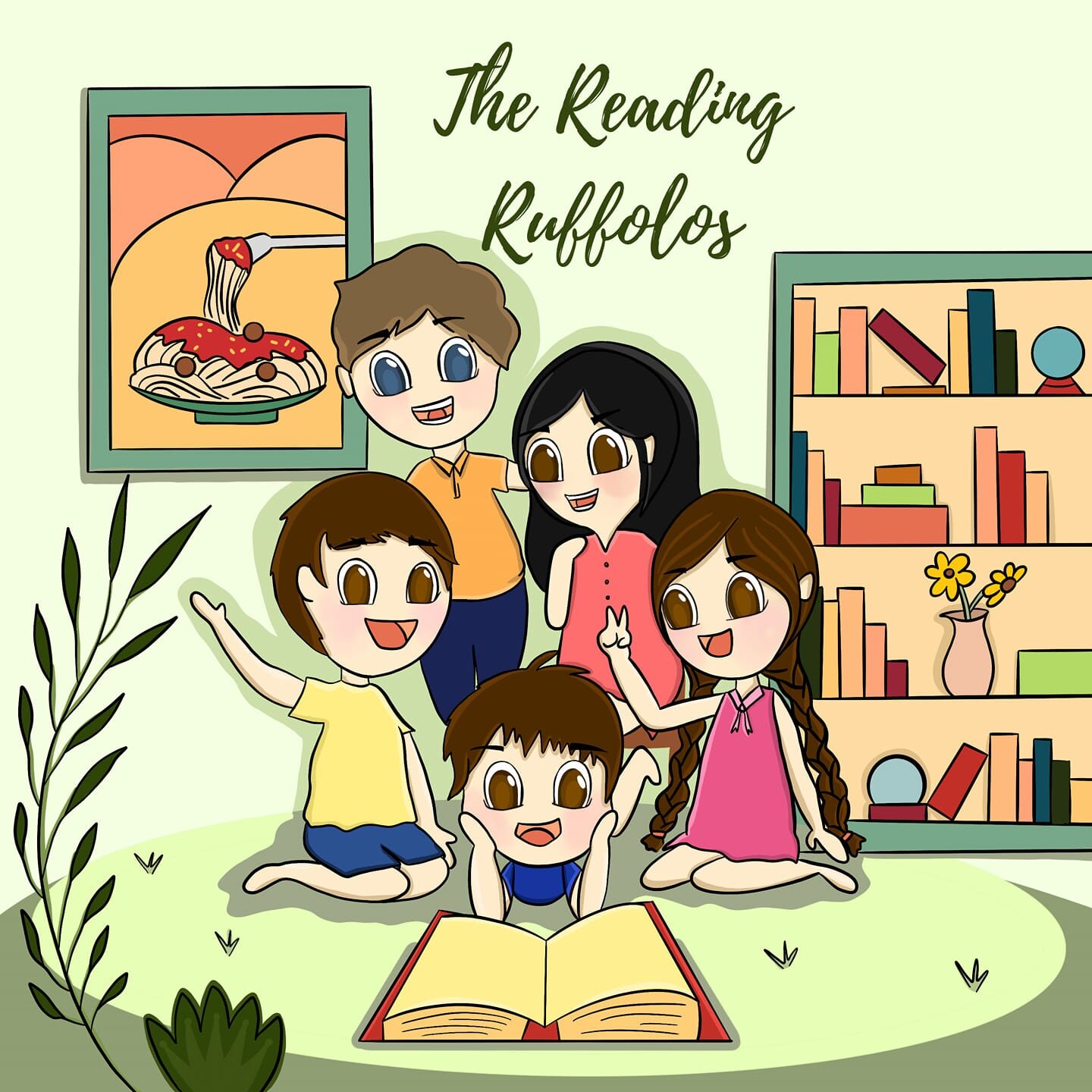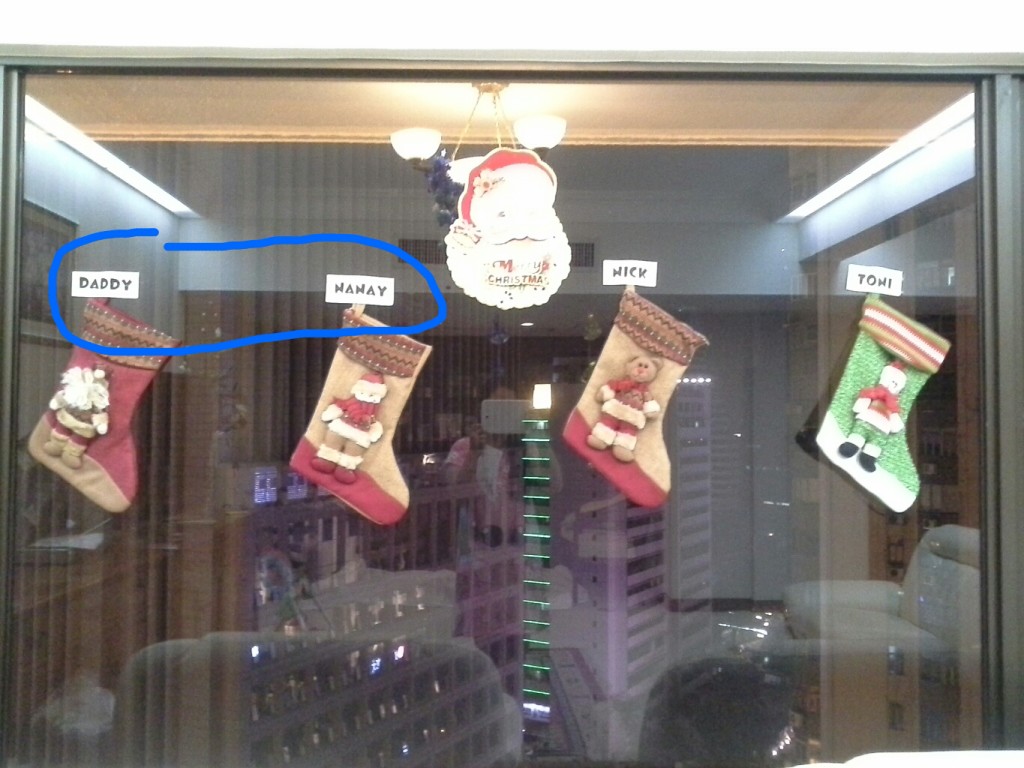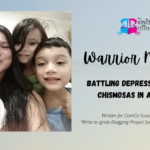This is a post I wrote in one of our group discussions in my Foundations in Reading and Literacy class last December 2014.
For this discussion forum, I am sharing two recent experiences: (1) comments from a Facebook photo I posted last Tuesday; and (2) learnings from the book “7 Steps to Raising Bilingual Kids” by Dr. Naomi Steiner.
Two persons sent me a private message commenting about the labels on our stockings (blue circle). Jeff, my husband, is Daddy; I am Nanay. My friends asked me why I want myself to be called “Nanay”. I replied: “Why not?” One friend told me that Nanay is only used to refer to older women. I corrected her and said that was not the case because the last time I checked, Nanay means mother, not old woman.
The second friend told me it’s awkward to have “Daddy” and “Nanay” especially that my husband is Italian American. I stopped myself from going into an etymology and cultural lecture. I am seriously tired of explaining to people why I have my children call me Nanay, but I always find myself talking about why I prefer “Nanay” to “Mommy”. I will explain this as I go along my sharing of the affirmations and learnings I gleaned from Dr. Steiner’s book.
I recently reread this book when I realized that I should actively speak to my twins in Cebuano when I heard them speak some Cebuano words without consciously teaching them those words.
Here are my affirmations and learnings from the book – and why my husband and I decided to make Cebuano and English the languages we speak at home (apart from Mandarin Chinese which the helpers speak, and which I also speak):
1. Cultivate Pride of Place
I was not even pregnant when I decided to let my future kids call me “Nanay”. It was a conscious decision. I wanted my kids to be proud of their origins. My children are Filipinos and Italians by blood; they are Filipinos and Americans by citizenship. They come from countries whose culture and tradition are two of the world’s best; well, make that three. I believe that language is a manifestation of one’s cultural identity. It is the purest expression of one’s culture. I am proud of being a Filipino, particularly a Cebuano and I’d like to share the same pride of place to my children. No matter where we are in the world, I’d like to share a piece of the Philippines to them. Teaching them Cebuano, actively conversing with them in my first language, is my way of cultivating in them the thought and the truth that them being Filipinos is NOT any less valuable than them being Americans.
2. Set Language Goals
Of course, Jeff and I realized that raising bilingual kids will require effort and time from the both of us. It’s no small feat for two individuals who are equally busy with professional and personal concerns. But to us, family comes first and our children is a very important part of this unit that we call family. We realize that there will always be a dominant language, and that would be English. Jeff and I agreed early on that Cebuano and English are not competing languages; instead they are two languages that complement each other because each parent speak one of the two languages. Jeff does not speak any word in Cebuano, but he understands the reason why we are taking this path. At the very least, for Cebuano, we’d like our twins to be able to speak the language; that when they go home to Cebu, they are able to converse with their grandparents, aunts, uncles, and extended family members. That’s our basic goal for Cebuano. For English, it will cover listening, speaking, reading, and writing – the entire package. We haven’t decided on Mandarin Chinese yet. We have to discuss this third language although we realize that they will learn the language because we live in China, we are surrounded by people who speak the language, we have helpers who speak the language, and they hear me talk to the helpers in Mandarin.
3. One-Parent-One-Language Method
In the book, Dr. Steiner talked about the importance of having and following a Bilingual Action Plan. The options and possibilities are endless. One can get creative and innovative in ensuring that your children constantly use their languages. What I like best in this book is her discussion on the One-Parent-One-Language Method (OPOL). I like it because it delineates the task of language teaching/sharing to both parents. It is also easier for both parents as they can practice their respective languages with their children. The children, on the other hand, have language partners giving them opportunities to practice the languages. Jeff and I are doing this. I speak Cebuano; he speaks English. We’re not hearing any code switching yet; no mixing of languages as the twins are only 17 months old. But we do hear an English word here and a Cebuano word there. For example, when Jeff left for Hong Kong this morning, Nicholas and Antoinette said: “Ba! Ba!” (which means “bye”) as they waved their hands. After dinner, Nicholas gave me a plastic cup, pointed at the water dispenser and said, “Big”, that’s tubig or water.
4. Motivation, Instruction, Practice
Apart from the innate ability of the child to learn a language, these three make up a lethal, powerful combination ensuring optimal language learning. I’ve been reading to the twins even before they came out of this world. A few days after they were born, I shoved books into their hands. They can now hold a book properly and leaf through its pages with ease. We read any time of the day and though Antoinette does not have the same attitude about “reading” than Nicholas (the girl moves around when I’m telling a story, while the boy stays put), I continue to read because I know she’s listening. By August 2015, we are putting them in a day care and I don’t know yet what type of instruction there is here in China. I will be doing my research but I think it is crucial that I find one that practice storytelling and play time. We hope that by being active communicators to our children, we give several opportunities and the much needed exposure and time for them to practice these languages.
5. Reading Materials in Cebuano
One of the drawbacks in teaching Cebuano though is the lack of resource materials in the language. I scoured National Bookstore in December 2012 for children’s books in Cebuano when I found out that I was pregnant with twins. I found three titles from Adarna that had Cebuano and Filipino in one story. A book in Cebuano and English was later released by the Ramon Aboitiz Foundation, Inc. However, most of these books are directed towards school-aged children. I honestly have a hard time looking/finding books for my 17 months old. My solution has been to make resource materials of my own. I wrote two simple stories in Cebuano and alternately read these stories to the twins. My next step is to have these stories illustrated by my brother or by one of their godmothers. I am also looking for children’s songs in Cebuano because as far as I can remember, most of the children’s songs I learned and sang as a child are in Tagalog/Filipino. My twins are exposed to Cebuano songs but most of these songs are the kundiman type and Bisaya rock.
Dr. Steiner discussed the role of a parent as a language coach and already, I am thinking about how difficult this journey will be. But Jeff and I do not give up without a fight – and like any parent who wants the best for their children, we made a commitment to make this work. It’s going to be a long journey and we need to fill our backpacks with the necessary knowledge, skills, and values to come out alive, er, successful in this bilingual adventure.




